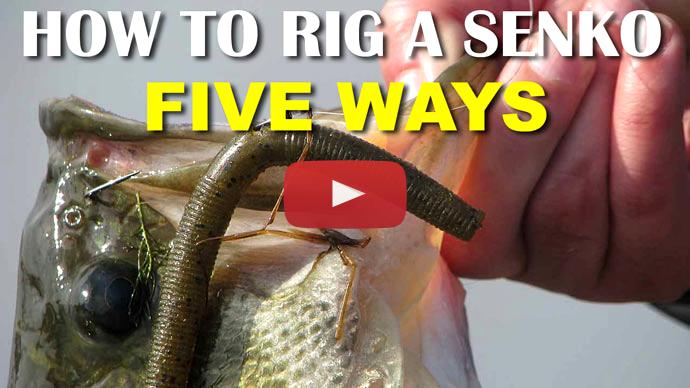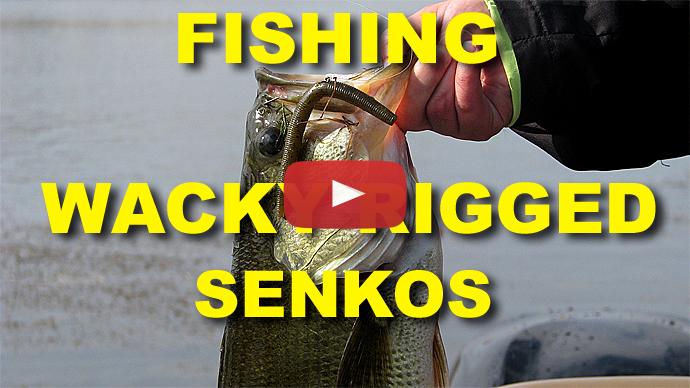Hey folks, Glenn May here with BassResource.com. Today I want to talk with you about fishing wacky rigged worms. This is a great way to catch fish, almost year-round, really. It's a great method to do it. And all's it really is, you're just taking a straight-tailed worm, any size, and just sticking the hook through it. That's the basic setup. Just sticking the hook right through the middle. That's all it is. Looks like that. Okay? Very basic. It's kind of an odd way of fishing it. There's many theories on how it came to that origin, but I'm not going to get into that today.
Now, to rig it, there's all kinds of different ways to do it. Matter of fact, it's been so popular that it spawned kind of a cottage industry. There's all kinds of O-rings, there's weighted O-rings, there's specialized hooks, special jig-heads. It goes on and on and on. You can go hog wild with all the specialized things you can get for fishing wacky rigs.
For me, I like to keep things simple and basic. I want to keep my tackle organized and clean. So I try to shy away from one-off stuff, things that are just one-trick ponies that are useful for only one type way of fishing. You can't get completely away from it, but with wacky rigging, you can. So I don't buy any O-rings. I don't buy specialized weights and hooks. I just re-purpose the stuff I already have in my tackle box.
Now if you use all this stuff and you use those O-rings and you feel that it works great for you and helps the worms last longer and they don't tear up and that kind of thing, man, knock yourself out. Have fun with that. There's nothing wrong with that. I'm just telling you, for me, I try to shy away from all of that stuff. I just use a jig-head. And in this instance, I'm fishing a four-inch hand-poured lure, and that's what you want. You need a bait that's got a little flexibility, quite a bit of flexibility. So a hand-poured for me is what I use.
And just a little ball-head jig with a wire guard. Can you see that wire guard on there? And that wire guard kind of keeps the weeds and stuff off of it. It helps prevent me from hooking up on any wood or branches or weeds and all that kind of debris on the bottom. A very basic setup if I'm fishing in say rocky areas, I might switch to a football head jig or if I'm fishing really weedy then instead of using a ball-head I might use more of a bullet sinker kind shaped head. But that's about it. I got a whole bunch of different jig-heads in my boat, so I just re-purpose what I have. Makes it real easy that way and keeps the clutter down.
In the springtime, I might get a little bit bigger. I might be using a six-inch worm with a heavier jig-head. In those cases, I might be fishing it on a lot thicker line. Today I'm fishing the spinning tackle. I'm using six-pound fluorocarbon on it. Okay? Real light finesse approach. Fluorocarbon is really sensitive. You're going to need that with a real light bait. I don't use braid, because braid is more buoyant and it kind of drags on this bait and inhibits the way it falls.
And that's another key thing. I use a weight on here. Now some people will fish a wacky rig weightless, but to me, that doesn't work. The whole beauty of this bait is as it falls, it does this action, all the way down, okay? It just flutters, really nicely. The weight accentuates that. The weight it falls down faster and it wriggles really nicely. If you are fishing weightless, just a hook on there, I feel it just kind of falls like that. It really doesn't move. It might move a little bit but the hook isn't weighted enough by itself to cause that action.
If I'm going to fish it weightless, then I'll just fish it Texas rig much like I do a Senko and I'll fish it that way. So for me, a weight is critical. This is just a 3/16-once weight, a real light weight, fishing on six-pound fluorocarbon line, straight fluoro. I don't use leaders or anything like that. I want a direct connection to it. The less leaders and less knots I have between me and the bait, the less likelihood I have for break-off. So it's straight fluoro.
Fishing on a spinning rod. I've got a seven-foot medium light action rod here, perfect for this setup. It's a light wire hook that I'm fishing, so the rod has to have some flex and to give to it some bend. So when I’m fighting a fish, I don't want to straighten the hook out nor do I want to break the line. So nice medium light action rod, perfect for this setup.
As far as colors are concerned, the colors of baits ... you know it's funny, I have not found any kind of connection as far as color and how many fish I catch. It's all about the action. I don't even know the name of this color, honestly. It's a hand-pour that I get from Don Iovino. You can look them up online and find his baits. I've fished all different kinds of colors, white, black, everything in between, and I've caught fish on it. So I think it's more about the action than it is the color. But as a general rule of thumb, natural colors tend to produce in clear water or most conditions. Green pumpkin is your old standby. So if you really don't know what to use, fish a green pumpkin. You can't go wrong with that. Like I said, it's more about the action than the color.
All right, so there's the lure. There's the line we're going to use, the rod, the setup, the whole nine yards. Now let's go fish it.
What I have here is a long tapering point that I'm fishing, and I'm right toward the end of it, right where it drops off into deeper water. That's a perfect candidate for the wacky worm. All you're going to do is cast out there and let it fall on slack line. Watch that line carefully. Watch where it enters the water. See if it twitches, pops, jerks, does anything unnatural, anything that you that you didn't cause, well something on the line is playing volleyball with it so you better set the hook. So pay close attention to that line when you throw it out there.
Just toss it out there, flip the bail over or engage your reel, and then just carefully watch that line as it falls. Let it fall all the way down to the bottom, straight down. Just let that worm do its thing as it goes all the way down. That's the action that's enticing. That's what the fish want.
Once it hits the bottom, and it's really easy to tell when it hits the bottom, because the line just goes slack on you. So there, it hit the bottom. Just lift up. I got some weeds down there. It went a little too shallow here. I've got to reel this back up and go back out because I just picked up a weed.
What you're going to do is you're just going to work it back to the boat, nice and slow and let the bait do its thing. Let's cast that out a little bit further. I’m trying to get right on the weed line. I went a little too much on the inside of it. So let it fall. Watch that bait. Watch that line as it drops. Make sure fish doesn't pick it up as it's falling, because that's the key to this bait. A lot of times those bites happen on slack line.
All right, now it's on the bottom. Lift up and let it drop. Bring your rod tip right down to the nine o'clock position and bring it back up to about eleven o'clock and follow it on down. Just go right on back down with it. So as it's dropping, you want to reel up the slack, but you don't want to reel the bait. Just reel up. Go up to about the 11 o'clock position. Drop the rod tip down as you're reeling. Let that bait fall naturally, but you're kind of keeping connection with it. And this is what some people call it, letting it fall on a semi-slack line. When they refer to that, that's what that's all about. I picked up a couple more weeds again, right on the edge of that.
But since I'm picking up weeds, I'm going to show you another technique. This is how you fish it across weeds. This time, you don't let it drop all the way down. Let it drop quite a bit, but don't let it drop completely. Then what we are going to do, we are going to kind of swim it back. You want to keep it just over the tops of the weeds. It's just a steady reel. Hold the rod tip about nine o'clock, seven o'clock position, eight o'clock, somewhere in there. You want to keep it ready for that strike. You always want to be ready for that strike. Just kind of reel it back in slowly, and you are going to let that worm do its thing underwater. I really don't know what it is that this bait resembles, honestly. But man, the fish just love it, absolutely love it.
So that's one way, just a straight retrieve. So we've done the lifting it back up and letting it fall back down and then a straight retrieve. Let me show you another one. When it reaches down at the bottom, now we're going to impart a little more action to it and get their attention. Lift up on it and see if there's any fish. I don't feel a fish. So you're going to pop it a little bit, just with the rod tip. Bring it back down and let the rod tip. It's the same action we had before, but now we're kind of jerking and popping it. We're giving it just a little bit of an action as it falls. Real great way to catch fish this way. All right?
And then finally, one other way I like to do it, I cast it back out there, let it fall again, pay real close attention to that line because that's when they always hit. But let it fall straight down. When it hits down there, you want to feel, just lift up a little bit and see if there's a fish on the other end. I don't feel a fish right now. I'm a little further off the point right now, and I'm letting it fall a bit further. Now what we're going to do, I think I'm away from those weeds, we're just going to drag it on the bottom. Just let it fall, let it sit. Give it a rest, and then you want to drag it a little bit more on the bottom, okay? And here you're just crawling it along. I don't know, you just kind of make it like a fish that's injured or some kind of bait fish.
Those are just some of the different ways that you can fish this bait. Experiment. Play with it! There's all kinds of different things you can do. There's no right or wrong way to fish it. That's why this bait is so versatile, why so many people like it. They catch so many different fish on it. Different baits, different techniques, different tactics. It's a great, fun way to fish. Have fun with it. For more tips and tricks like this, visit BassResource.com.




